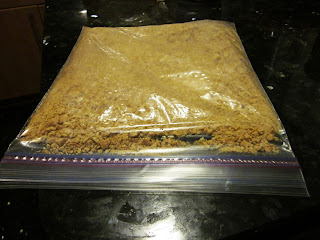
When the clock struck midnight on New Years Day, that marked the halfway point between our two birthdays. What better way to spend the afternoon before that moment to make cheesecake?
We pulled the crust and cake recipes from two different sources. The cake recipe does not include any eggs. In its stead, we used cornstarch, which, if you read our article on thickening agents, you'll know can serve as a perfectly ample substitute. The crust recipe (naturally egg-less) works with not only cheesecake, but any pie that suits your fancy.
Our NFPA Rankings:
Prep time: The bulk of your time will be spent waiting for your cake to bake. Mixing the ingredients and constructing the cake only take about 20 minutes total.
Difficulty: This recipe is easy. Crust? Mix all of the ingredients together. Cake? Mix some of the ingredients together, bake it for a while, mix the rest in, and bake a little more. It is really hard to make a mistake.
Course: Cheesecake. It's what's for dessert.
 |
Figure 3. Stick your graham crackers in a zip-lock bag
and crush.
|
Crust (Bottom Layer)
Cinnamon graham crackers (GC) - 1.5 cups (1 package of 9-10 GCs)
Sugar - 0.33 cups
Butter - 6 tbsp (melted)
Cinnamon - 0.5 tsp
1) Crush the graham crackers into very fine crumbs (Fig. 3)
2) Mix all of the ingredients together
3) Using the back of a spoon, press the crust into the bottom of a springform pan
 |
| Figure 4. Middle Layer of Cheesecake |
Cake (Middle Layer)
Cream cheese - 8 oz
Sugar - 1 cup
Cornstarch - 1 tbsp
Vanilla - 1 tbsp
1) Mix all of the ingredients together
2) Pour into the pan spread it evenly over the crust
3) Bake for 35 minutes at 350 ºF
4) Let it cool for 5 minutes after baking (IMPORTANT!!!)
 |
| Figure 5. Top Layer of Cheesecake |
Sour cream - 1 pt
Sugar - 0.5 cup
Vanilla - 1 tsp
Strawberries
1) Mix all of the ingredients together
2) Spread on top of the first layer
3) Bake for 10 minutes at 400 ºF
4) Chill in the refrigerator
5) Slice some strawberries and arrange them on top of the cake in an aesthetically pleasing pattern.
Results
How can we describe this cake? To put it straight: this is the most amazing dessert we have ever made, and quite possibly one of the best desserts we have ever eaten. The cake itself was sweet, but not overpowering, as the tartness of the sour cream balanced out the sweetness of the rest of the cake. The graham cracker crust was moist and not grainy, sweet and not bitter. We are definitely happy with our decision to purchase cinnamon graham crackers at the grocery store (as opposed to honey), as the sharp taste of cinnamon proved to be the perfect addition to our smooth, sweet cheesecake.
 |
| Figure 6. Our Completed Cheesecake |
To put it simply, it is not possible to describe how we felt when we consumed this confection. If we were to try, we would only shame ourselves and disrespect the cake itself. Each bite brought us closer to enlightenment, and reaching the crust was our awakening. You should really sit down if you want to eat this cake. We're not exaggerating. Try this recipe and you'll see. If you need a break from life, take in the intoxicating taste of this cake, and let all of your stress melt away.
Discussion
 |
| Figure 7. Sucrose |
 |
| Figure 8. Caramelized Sugar |
It is difficult to determine the exact chemical process that occurred in our oven. First, the cake cooked at two temperatures, 350ºF and 400ºF, or just below and just above the melting point for sugar, respectively. Second, ovens tend not to be entirely accurate in setting their temperatures, therefore the exact relationship between our cooking temperature and the chemical state of our cake can not be resolved precisely. More cooking and testing must be done to fully understand the dynamics of caramelization. However, we're not going to repeat this experiment a bunch of times because we want to make other foods.
References
1) McGee, H. September 2012. "Caramelization: New Science, New Possibilities." Curious Cook
2) Schmidt, S.J. Exploring the sucrose-water state diagram. Manufacturing Confectioner, January 2012, 79-89.


No comments:
Post a Comment